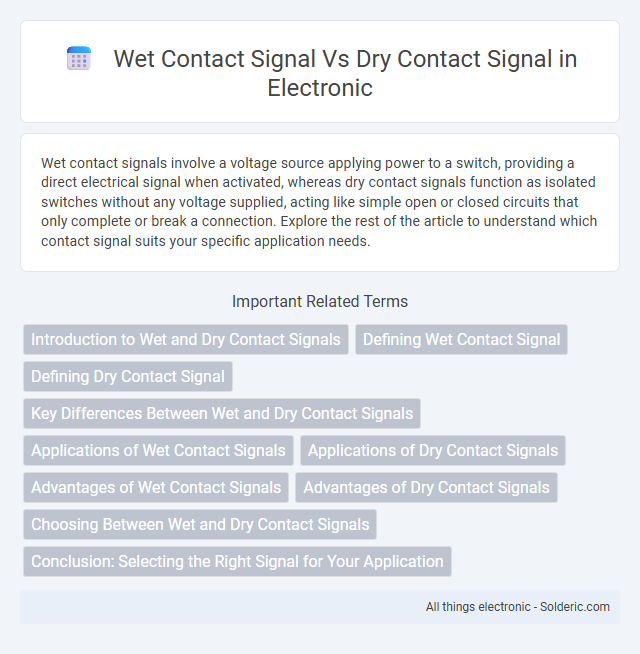Wet contact signals involve a voltage source applying power to a switch, providing a direct electrical signal when activated, whereas dry contact signals function as isolated switches without any voltage supplied, acting like simple open or closed circuits that only complete or break a connection. Explore the rest of the article to understand which contact signal suits your specific application needs.
Comparison Table
| Feature | Wet Contact Signal | Dry Contact Signal |
|---|---|---|
| Definition | Contact that carries its own voltage or current. | Contact acts as a simple switch without voltage. |
| Voltage Source | External voltage applied through the contact. | No external voltage; circuit is powered separately. |
| Signal Type | Active electrical signal. | Passive contact closure. |
| Wiring Complexity | Requires correct voltage compatibility. | Simple, low voltage wiring. |
| Use Cases | Alarm systems, sensors with powered outputs. | Switch panels, relay interfaces, dry loop signaling. |
| Advantages | Provides a clear, stable signal. | Universal compatibility with control systems. |
| Disadvantages | Voltage mismatch risk; needs protection. | Requires external power for signal detection. |
Introduction to Wet and Dry Contact Signals
Wet contact signals use an external voltage source to indicate a switching event, providing a powered circuit output commonly found in industrial control systems and alarm panels. Dry contact signals function as simple mechanical switches without any voltage applied, offering a passive, voltage-free closure frequently used for relay or sensor inputs. Understanding the distinction ensures proper compatibility and safe integration within various electrical and electronic control applications.
Defining Wet Contact Signal
A wet contact signal refers to an electrical signal in which an external voltage source is applied to a switch or relay contact, allowing current to flow when the contact closes. This type of signal typically involves a powered circuit, where the presence of voltage indicates the contact status. Wet contacts are commonly used in industrial control systems for reliable detection and signaling.
Defining Dry Contact Signal
A dry contact signal refers to a switch or relay output that does not supply voltage or current but simply acts as an open or closed electrical connection, allowing your device to detect on/off states without interference. Unlike wet contact signals that provide a voltage source, dry contacts rely on external circuits to supply power, ensuring compatibility with various control systems. Understanding dry contact signals is essential for integrating sensors, alarms, and automation devices safely and effectively.
Key Differences Between Wet and Dry Contact Signals
Wet contact signals utilize an external voltage source to activate the relay or switch, ensuring a powered and isolated output, whereas dry contact signals operate as simple mechanical switches with no voltage applied, relying solely on the circuit they control. Wet contacts provide more reliable signal transmission in noisy environments due to their powered nature, while dry contacts are preferred for their simplicity, safety, and compatibility with low-voltage control systems. The choice between wet and dry contact signals depends on application requirements such as voltage levels, isolation needs, and control circuit design.
Applications of Wet Contact Signals
Wet contact signals are widely used in industrial automation, HVAC systems, and security alarms due to their reliable voltage presence for device activation and monitoring. These signals provide direct electrical power, making them suitable for controlling relays, motors, and lighting systems requiring precise voltage levels. Wet contact implementations ensure stable signal transmission in environments demanding consistent electrical connections and minimal interference.
Applications of Dry Contact Signals
Dry contact signals are widely used in security systems, industrial automation, and building management for reliable, low-voltage device status monitoring and control. They enable seamless integration with alarms, access control systems, and relays without the risk of electrical interference or voltage mismatch. Their versatility makes them ideal for applications requiring isolated switching and precise detection of open or closed circuit states.
Advantages of Wet Contact Signals
Wet contact signals provide reliable electrical continuity by supplying an external voltage source, ensuring consistent operation in industrial control systems and preventing signal degradation caused by resistance or corrosion. They offer enhanced compatibility with a wide range of devices and allow for easier integration with modern automation equipment due to their standardized voltage levels. The presence of a powered signal reduces false triggering and improves overall system safety and diagnostics in complex control circuits.
Advantages of Dry Contact Signals
Dry contact signals offer greater compatibility with a wide range of devices because they provide a simple, voltage-free switch mechanism, ensuring minimal interference and noise in signal transmission. These signals are highly reliable for monitoring and control applications as they do not rely on an external power source, reducing the risk of electrical faults and increasing system safety. Their versatility makes them ideal for integration in industrial automation, security systems, and alarm panels where signal integrity and equipment isolation are crucial.
Choosing Between Wet and Dry Contact Signals
Choosing between wet and dry contact signals depends on the voltage and current requirements of the control system. Wet contact signals supply their own voltage, making them suitable for systems that require a powered input, while dry contact signals act as simple switches without voltage, ideal for low-voltage or sensitive control circuits. Selecting the appropriate contact type ensures compatibility with the device's input specifications and enhances system reliability.
Conclusion: Selecting the Right Signal for Your Application
Wet contact signals provide a powered voltage, ensuring compatibility with devices requiring a specific voltage range and offering more reliable noise immunity, while dry contact signals supply a simple open or closed circuit, ideal for low-voltage and low-current applications. Choosing between wet and dry contact signals depends on factors such as voltage compatibility, environmental noise, and the type of equipment being controlled. For applications demanding signal integrity and device protection, wet contact signals are preferable; dry contacts suit simpler, cost-sensitive setups with minimal electrical interference.
wet contact signal vs dry contact signal Infographic

 solderic.com
solderic.com